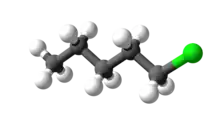 | |
| Names | |
|---|---|
| Preferred IUPAC name
1-Chloropentane | |
| Other names
n-Pentyl chloride; n-Amyl chloride | |
| Identifiers | |
3D model (JSmol) |
|
| ChEMBL | |
| ChemSpider | |
| ECHA InfoCard | 100.008.043 |
PubChem CID |
|
| UNII | |
CompTox Dashboard (EPA) |
|
| |
| |
| Properties | |
| C5H11Cl | |
| Molar mass | 106.59 g·mol−1 |
| Appearance | Liquid |
| Density | 0.88 g/cm3[1] |
| Melting point | −99 °C (−146 °F; 174 K)[1] |
| Boiling point | 108 °C (226 °F; 381 K)[1] |
| 197 mg/L[1] | |
| Hazards | |
| Flash point | 3 °C (37 °F; 276 K)[1] |
Except where otherwise noted, data are given for materials in their standard state (at 25 °C [77 °F], 100 kPa).
Infobox references | |
1-Chloropentane is an alkyl halide with the chemical formula CH3(CH2)4Cl. It is a colorless, flammable liquid. It can be prepared from 1-pentanol by treatment with hydrogen chloride.[2]
See also
References
- 1 2 3 4 5 Record in the GESTIS Substance Database of the Institute for Occupational Safety and Health
- ↑ Copenhaver, J. E.; Whaley, A. M. (1925). "N-Butyl Chloride". Organic Syntheses. 5: 27. doi:10.15227/orgsyn.005.0027.
This article is issued from Wikipedia. The text is licensed under Creative Commons - Attribution - Sharealike. Additional terms may apply for the media files.